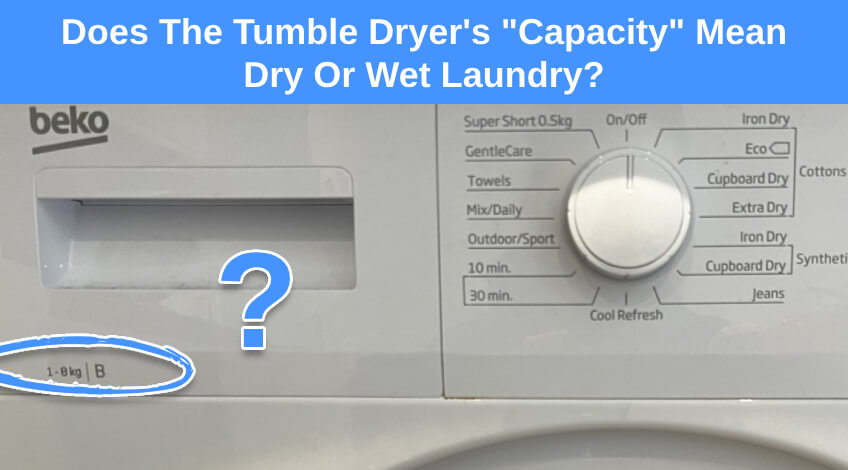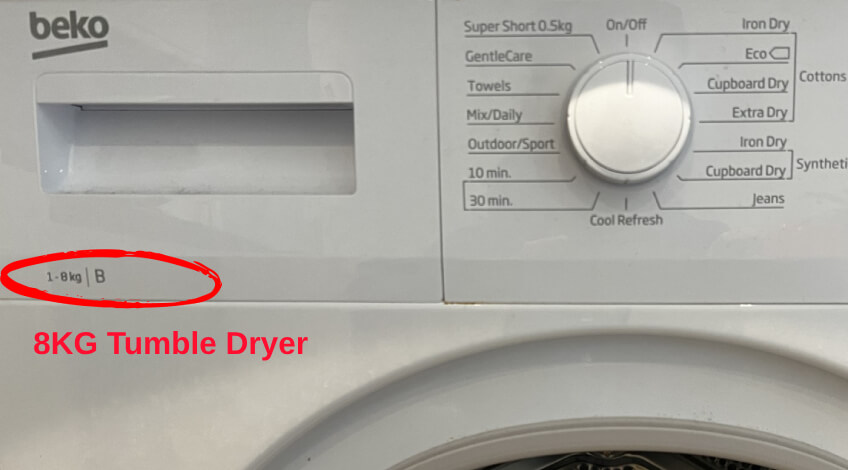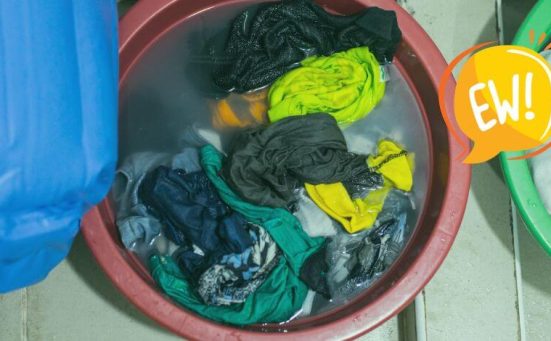
Does The Tumble Dryer’s “Capacity” Mean Dry Or Wet Laundry?
In the UK, the standard capacity for residential dryers is 8KG to 9KG, which is the perfect size for most small to medium households.
But is the capacity of the dryer referring to wet or dry clothes? Essentially, the capacity of a dryer will refer to the dry weight of your laundry.
What Does The Capacity Of The Tumble Dryer Refer To – Wet Or Dry Laundry?
To keep it simple: In every tumble dryer, each has a capacity which will determine the maximum weight of laundry it can dry per load. The capacity being referred to is the weight of the laundry when it’s dry, not when it’s already washed and wet.
Although it makes sense that wet laundry weight will be considered as it is heavier, this is not the case for the manufacturers.

What about washing machines? As with tumble dryers, the weight capacity will still be talking about dry laundry.
Here is what some manufacturers are saying on their website:
- Beko
In their manuals, the technical specifications and maximum capacity of a dryer will be measured in “dry laundry weight before washing”.[1] - Sharp
In their manuals, the maximum capacity of the dryers will be measured in “dry laundry weight before washing”.[2] - Samsung
“Measured in kilograms, this capacity usually ranges from 6-18 kg and is always measured in terms of dry clothes, never wet”.[3] - LG
“The capacity of a dryer is measured in kg, and refers to the dry weight of the load, not the wet weight”.[4] - Hotpoint
Hotpoint measures the max load for their tumble dryers using “dry load”.[5] - Miele
Miele measures the maximum load in their tumble dryer using “dry weight”. - Indesit
“An appliance’s drum capacity always refers to dry laundry, not wet”.[6]
Understanding The Weight Capacity of Tumble Dryers
Although tumble dryers have maximum capacities, this does not mean that an 8KG dryer will always need to dry 8KGs worth of laundry.
In fact, most manufacturers would recommend only putting in laundry that will at least be around 1/2 to 3/4s of your dryer’s drum. This way, you will not be underloading or overloading your tumble dryer, which is bad for your appliance and resources.
Here is the minimum and maximum capacity load for 6-11KG tumble dryers*:
| Weight Of Each Load Size By Capacity | Minimum Load | Maximum Load |
|---|---|---|
| 6KG Tumble Dryer | 3KG | 4.5KG |
| 7KG Tumble Dryer | 3.5KG | 5.25KG |
| 8KG Tumble Dryer | 4KG | 6KG |
| 9KG Tumble Dryer | 4.5KG | 6.75KG |
| 10KG Tumble Dryer | 5KG | 7.5KG |
| 11KG Tumble Dryer | 5.5KG | 8.25KG |
*This also applies to washing machines.
Underloading your tumble dryer is a waste of resources, and it will lead to inefficient drying. On the other hand, overloading your dryer is harsh on your garments and appliances, straining them and damaging them in the long run.
NOTE: Different programmes will have different maximum capacities. Make sure to read your tumble dryer’s manual or you may notice that your clothes are still damp and even wet after spinning.
The Average Weight Of Clothing
To give you an idea as to how much clothes actually weigh, here is the average weight of the garments many of us wear every day:
| Clothing Item | Average Weight (kg) |
|---|---|
| T-shirt | 0.2 kg (200 grams) |
| Trousers | 0.7 to 0.9 kg (700 to 900 grams) |
| Dress | 0.3 to 0.8 kg (300 to 800 grams) |
| Sweatshirt | 0.5 to 0.7 kg (500 to 700 grams) |
| Blouse | 0.2 to 0.3 kg (200 to 300 grams) |
| Shirt | 0.2 to 0.3 kg (200 to 300 grams) |
| Shorts | 0.2 to 0.4 kg (200 to 400 grams) |
| Socks (pair) | 0.05 to 0.1 kg (50 to 100 grams) |
| Underwear (pair) | 0.05 to 0.1 kg (50 to 100 grams) |
Keep in mind that these are average weights, and individual items may vary. However, this gives you a rough idea of how much your laundry weighs when dry.
Making the Most of Your Tumble Dryer
Now that you understand that the capacity of your tumble dryer refers to the weight of dry laundry, you can make the most of your appliance. Here are some tips:
1. Don’t Overload
Resist the temptation to stuff as much laundry as possible into the drum. Overloading leads to uneven drying, and your clothes may come out damp in places.
2. Don’t Underload
Running your dryer for small loads is wasteful. Try to group similar fabrics and items together to maximise each load’s capacity.
3. Check Your Dryer’s Manual
Different dryer models may have specific recommendations for load sizes and programs. Always consult your dryer’s manual for the manufacturer’s guidelines.
4. Use the Right Program
Most dryers offer various drying programs, such as delicate, cotton, and quick dry. Choosing the appropriate program for your load can ensure efficient drying.
5. Regular Maintenance
Keep your dryer lint filter clean, and ensure proper ventilation to maintain your appliance’s efficiency.
6. Don’t Forget to Shake
Before tossing your wet laundry into the dryer, give each item a good shake. This helps reduce wrinkles and speeds up the drying process.
Dry Your Clothes The Right Way!
So, the next time you load up your tumble dryer, remember that its capacity refers to the dry weight of your laundry.
It’s always best to consult your appliance’s manual for specific instructions and to avoid overloading or underloading your dryer to ensure efficient and effective drying. By understanding your dryer’s capacity, you can make the most of this essential household appliance while keeping your clothes in great condition.
SEE ALSO: Does Putting An Ice Cube In The Tumble Dryer Take Out Wrinkles?
Frequently Asked Questions
When a washing machine says 8KG, it refers to the dry laundry weight, not wet.
The size of the tumble dryer you need depends on your laundry load size and frequency. For small to medium families, an 8 or 9KG dryer or smaller can get the job done. If you have a bigger household or have kids that need to change clothes often, then getting a 10KG dryer or bigger would be more efficient.
Whether a bigger or smaller dryer is better depends on your laundry needs and available space.
Yes, the size of the dryer matters, as it affects its capacity and drying efficiency.
Smaller dryer loads tend to dry faster due to better air circulation.
Also, follow us on Pinterest ...



